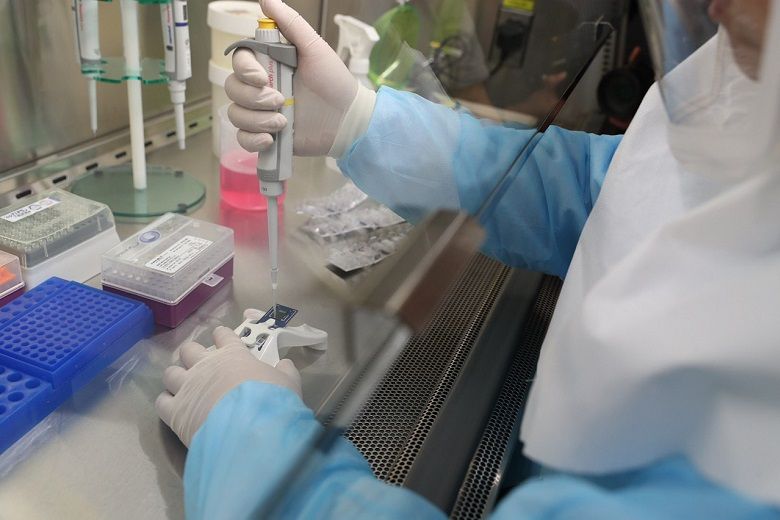No evidence yet that different virus 'types' could affect severity of condition
Sign up now: Get ST's newsletters delivered to your inbox

A photo taken on March 5, 2020 shows a Home Team Science & Technology Agency scientist demonstrate a process with their coronavirus test kit at their laboratory in Singapore.
ST PHOTO: TIMOTHY DAVID
Follow topic:
As viruses are not static but prone to mutation, it is no surprise that there are subtle variations in the coronavirus causing Covid-19, Associate Professor Kenneth Mak, director of medical services at the Ministry of Health (MOH), said yesterday.
"This is naturally due to mutations and how the virus evolves," he said.
But as the biological behaviour of the different strains is still being studied, it is not yet clear whether any of the virus subtypes are more aggressive, more virulent or behave differently, said Prof Mak.
He was responding to questions from the media at a news conference on a recent study by Chinese scientists who found that two types of the coronavirus - L and S types - appeared to exist.
The researchers said in their study, which was published on Tuesday in the scientific journal National Science Review, that the L type appears to be more aggressive and spread more quickly than the other.
Prof Mak noted that the Chinese study was done at the time when only 103 genomes of the virus were available on an international database. There are now 184 sequenced genomes, he said.
He added: "We continue to look at this carefully and await more information from our scientific colleagues, researchers, who are actively involved in studies on the natural behaviour of the virus, as well as for ways to treat this infection."
Dr Sebastian Maurer-Stroh, deputy executive director for research at the Agency for Science, Technology and Research's Bioinformatics Institute, who is among the scientists studying the evolution of the virus, said that as more sequences are being uploaded onto the database, "the data, not surprisingly, shows that the two variants they singled out are just two of many highly similar versions of the same virus".
Dr Maurer-Stroh said: "But importantly, and this was a weakness of the study, there is no known association or hard evidence for changes of severity for any of these variants."
The study did not seek to analyse if the types of viruses identified had different properties, he said, but added that this was unlikely.
"It is important to note that the difference between these groups is minimal... and most variants by far are not linked to changes in severity, but could be neutral or even bad for the virus, making it weaker," Dr Maurer-Stroh told The Straits Times.
He said the differences between the two "types" can be likened to comparing two cars of identical type and colour, just with different licence plates.
"That licence plate helps you find out where the car was registered but not how fast it can go," he said, adding that more data is needed to determine the latter.
A virus' unique genome serves as a "fingerprint" to distinguish it from other viruses.
By comparing the genome of the virus causing Covid-19 with that of related viruses, scientists could identify parts of the genetic code that were unique to the virus, known as Sars-CoV-2.
These differences allowed scientists to develop a diagnostic test that will enable clinicians to diagnose patients with the virus.
The test works by flagging the unique parts of the viral genome in a process known as polymerase chain reaction.
Asked if the emergence of the different strains of the virus would affect the effectiveness of the diagnostic test kits, Prof Mak said that this does not appear to be the case.
"So far, the variations in the genetic make-up are in the areas that do not affect the testing of the virus," he said, noting that such tests are developed to be as sensitive and as specific as possible.
"(The tests are developed) by looking at common sites that are easily identifiable and not significantly prone to mutations, so even if the virus changes its make-up over time, the test will still remain sensitive," said Prof Mak.
But the tests will continue to be validated with samples from infected patients so as to ensure that they remain a valuable tool for diagnosis, he added.
The coronavirus is currently thought to spread mainly through respiratory droplets.
Outside a living host, such as a human, a virus cannot replicate and is generally not considered a living thing.
Prof Mak said the greatest concern for infection would be in the first few hours after a droplet lands on a surface, although the exact time may depend on the surrounding environmental conditions.
"Once the droplet dries up, the virus would not last very long outside that protective environment," he said.
The Straits Times had earlier reported that the structure of a virus has to remain intact for it to start infecting a host.
Various measures, such as exposing the virus to heat or through the use of disinfectants, break its structure, rendering it impotent and unable to infect anyone.
For instance, if a respiratory droplet lands in an open area in the hot sun and that droplet evaporates quickly, the exposed virus would not last very long, Prof Mak said.
"But in other settings, that droplet may, in fact, last for longer periods on the surface," he added.
During yesterday's news conference, a new SG Clean Taskforce was also announced.
To be headed by Minister for the Environment and Water Resources Masagos Zulkifli and comprising representatives from various ministries, it was set up to raise hygiene standards at a national level.

